List of [15 Indoor Plants Without Flower]: Examples and Care
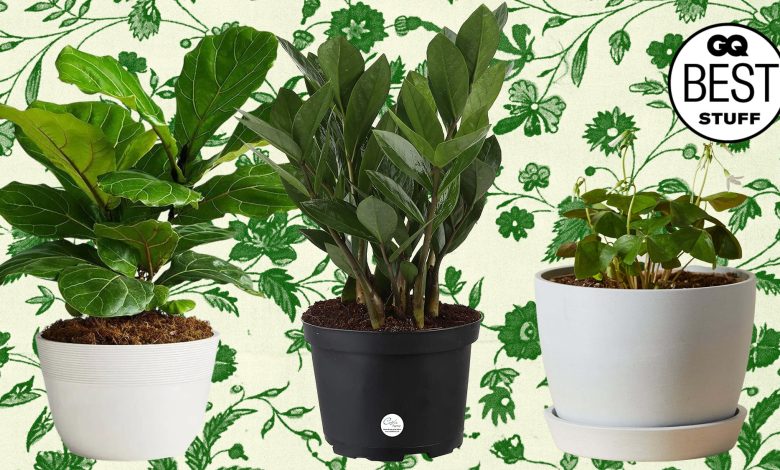
You will agree with me that who else who least likes to have plants inside their house.
We have already discussed flowering houseplants or those that are durable.
But what about non-flowering houseplants? What care do they have? Which ones are the best for me?
In this article we show you a list of 15 non-flowering indoor plants that you can care for, grow and enrich the interior of your home in this way.
croton
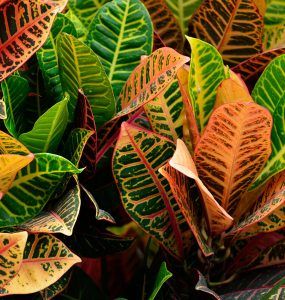
The Croton or Codiaeum Variegatum Pictum belonging to the Euphorbiaceae family, is afabulous indoor plant, thanks to the color of its large leaves.
These are its biggest attraction. They are hard, ribbed with perfect colorful brush strokes in shades of yellowish, orange, green, variegated, pink, cream, black and reddish that attract everyone’s attention.
Originally from the South Pacific (Malaysia, Polynesia and Australia) its average height is about 90 cm and if it is pampered, its generous and unique foliage will shine in the home wherever you want to grow it.
There are varieties of very wide leaves, more elongated, short, of contrasting combinations and colors.
Take into account when buying a cretonne, which variety you are getting from your trusted nursery, because there are greater or lesser light and humidity requirements in certain species.
Do you know how many croton varieties exist? Around 750 worldwide.
Maintaining more or less the same conditions as before arriving at your home, will guarantee that you do not lose foliage. She is considered delicate because she doesn’t like to be moved.
Syngonium
 The Syngonium or arrowhead, a plant with the scientific name Syngonium, is recognized by the peculiarity of its large, arrow-shaped leaves and a dark green tone with whitish veins that give beautiful nuances to its pronounced nerves.
The Syngonium or arrowhead, a plant with the scientific name Syngonium, is recognized by the peculiarity of its large, arrow-shaped leaves and a dark green tone with whitish veins that give beautiful nuances to its pronounced nerves.
It grows in the tropical jungle areas of Central and South America, where it develops a great ability to climb on rocks and very diverse trees.
More than twenty species are known, but the most popular are Syngonium podophyllum and Syngonium wendlandi.
It is a climbing plant, with a great capacity to grow in a short time, reaching a maximum height of about two meters. At some point during its growth, it will require you to support it with a stake to be able to stand upright.
Ideal for people who are not experts in the art of gardening, it comes from South America and belongs to the Araceae family.
Coleus or Cretonne
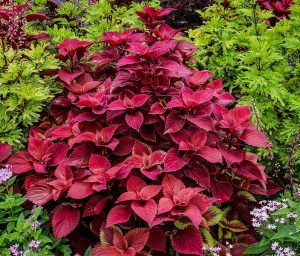 Coleus, cretonne or Solenostemon, is a beautiful semi-bushy plant, native to Southeast Asia.
Coleus, cretonne or Solenostemon, is a beautiful semi-bushy plant, native to Southeast Asia.
Highly showy, very striking due to its spectacular leaves arranged in pairs of intense colors, it can reach a meter in height outdoors, although in a pot it does not exceed 50 cm.
It should be noted that it works much better in closed spaces, because the direct sun burns its leaves.
Regardless of its cultivation, the combination of colors of its serrated leaves, whose sculpted edges with very vivid tones, contrast with yellows and purples, is absolutely stunning; brown, green and scarlet; or the fabulous bluish-purple mixtures of its leaves blessed by the hand of God.
If the conditions that we will describe below are met, do not hesitate for a moment to cultivate and give a lot of love to this spectacular plant.
Fittonia
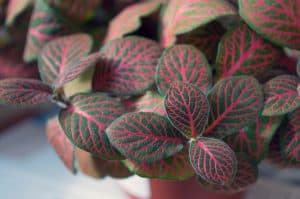 The Fitonia is a tropical plant as unique as it is beautiful. Its leaves are really curious, with differentiated patterns in the varieties that are presented, with colors ranging from white to pink or purple.
The Fitonia is a tropical plant as unique as it is beautiful. Its leaves are really curious, with differentiated patterns in the varieties that are presented, with colors ranging from white to pink or purple.
Its height in pot reaches about 10 cm to 15 cm maximum. That is why it is a creeping type plant, which will cast long stems horizontally. Hence, it is also considered as a ground cover plant.
The leaves are the main attraction. They measure about 3-5 cm at most, but they make themselves very noticeable thanks to a rich range of tones that go from yellow to red, with deeply sculpted nerves, which makes a contrast impossible to ignore.
Originally from regions of South America, it is widely seen in the jungles of countries such as Peru, Brazil, Ecuador and Colombia.
There is a mini Fitonia in very delicate shades of purple and white, ideal for combining it in an arrangement with other indoor plants, because it is a very good neighbor. Its flowers, not at all showy, appear in the spring.
chinese money plant
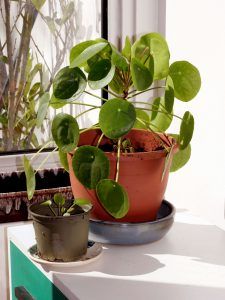 The Pilea Peperomioides or Chinese money plant is another plant used indoors for decorations. It has fleshy intense green leaves with a smooth surface and a rounded shape.
The Pilea Peperomioides or Chinese money plant is another plant used indoors for decorations. It has fleshy intense green leaves with a smooth surface and a rounded shape.
Its foliage, when very bushy, resembles many coins. Hence its popular name.
It is also known in some places as Missionary Plant. It is very common in southern China and is part of the Urticaceae family. He arrived in Europe in 1946.
It has the special characteristic that the stem that joins the bush with the leaf, the so-called petiole, is located in the center of it.
It is a small plant, maximum about 30 to 35 cm and the length of its famous leaves is about 10 cm.
Poto
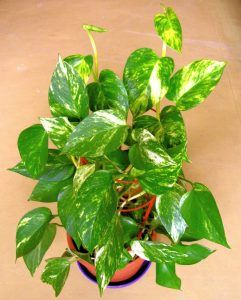 The Poto or Photos (Epipremnum aureum) is an indoor plant that should never be missing from your home. It is so versatile that it works as a hanging or tall plant. But above all, it does not require great conditions to develop, so growing it is very simple.
The Poto or Photos (Epipremnum aureum) is an indoor plant that should never be missing from your home. It is so versatile that it works as a hanging or tall plant. But above all, it does not require great conditions to develop, so growing it is very simple.
Without any exaggeration, this a-guan-ta-to-do plant belongs to the Araceae family. Most likely, this high resistance is due to its origin. It is born in the tropical forests of Southeast Asia. This has allowed it to achieve great adaptability in hot and seasonal climates around the world, both outdoors and indoors.
Its leaves, intense green with yellow or cream spots, are among the most resistant among the extensive group of so-called creeper plants. They have a heart-shaped base and an apex that ends in a point, of about 10 to 12 cm at most, but they can grow much more if they are stimulated and ideal conditions of light, temperature and humidity are maintained for their full development.
But the greatest benefit of this perennial plant is that it has been included by the National Aeronautics and Space Administration of the United States (NASA, for its acronym in English) in the list of the best purifiers of the environment.
Potho eliminates three toxins that pollute the environment and cause health problems for people. These are:
- Formaldehyde: is an environmental irritant that causes various types of cancer.
- Xylene: wreaks havoc on the nervous system and causes decompensation with nausea, vomiting and headaches.
- Benzene: causes fatigue, dizziness, tachycardia and even death if exposure is prolonged and in large quantities.
The Dieffenbachia camila
 Dieffenbachia are definitely very popular houseplants. Its stunning turned leaves are a real visual treat.
Dieffenbachia are definitely very popular houseplants. Its stunning turned leaves are a real visual treat.
All Dieffenbachia varieties have their own pattern on their leaves. Ideal for beginners, they come from tropical forests, where they shelter under the shelter of large trees. The shade that saw them grow in a wild environment has given them great strength and that is why they can live in houses, since they are experts in tolerating environments with low natural light.
Outdoors, some varieties are capable of reaching up to 10 meters in height, but most do not exceed 2 meters in elevation.
Sansevieria
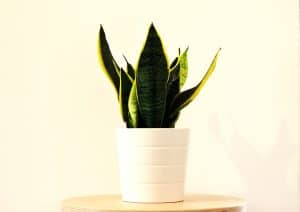 Sansevieria, the famous plant popularly called Mother-in-Law’s Tongue, is another champion of interior decorations. It does not require great care, it does not demand much and it is resistant.
Sansevieria, the famous plant popularly called Mother-in-Law’s Tongue, is another champion of interior decorations. It does not require great care, it does not demand much and it is resistant.
It was born in New Guinea, expanding throughout Africa and much of Asia. It is a succulent plant, of the Lilaceae family. In some latitudes it is known as Tiger Language.
About 70 species have been identified and are subdivided by the type of leaves: flat or thick. Among the best known are the Trifasciata, laurentii, cylindrical and zeylanica.
Most likely , Sansevieria Trifasciata is the best known. Its leaves are green, flattened and long. They are also distinguished by transverse white stripes and a maximum length of 120 cm.
The Calathea
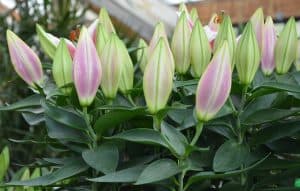 Another indoor plant of great nobility is the Calatea or Calathea, belonging to the Marantacea family. It has very striking leaves with attractive colors and shapes that change a little depending on the variety.
Another indoor plant of great nobility is the Calatea or Calathea, belonging to the Marantacea family. It has very striking leaves with attractive colors and shapes that change a little depending on the variety.
Its foliage is perennial, it remains green throughout the year, even in winter periods.
Coming from Brazil, the giant of South America, it has 25 species, some of which are known by the popular name of Zebra or Pregaria, thanks to the colorful colors and stripes on their leaves.
It is also found in wooded areas of Peru.
It can reach about 80 cm in height and if it receives the minimum necessary care, it will brighten up the corners of your house for a long time.
The Calathea rufibarba stands out as one of the most popular . It has elongated leaves of a deep dark green on the outside and a violet tone towards the center and on the underside, which attract a lot of attention. You will love having it at home.
Other varieties of this herbaceous species are: Calathea mackoyana, Calathea zebrina, Calathea insignis and Calathea ornata.
Amazon Alocasia
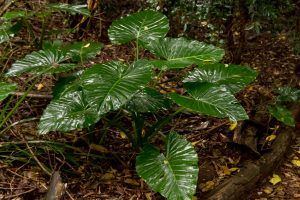 Another exotic plant of great beauty belonging to the Marquesas family is the Amazonian Alocasia.
Another exotic plant of great beauty belonging to the Marquesas family is the Amazonian Alocasia.
Popularly, it is also known as Elephant Ear. There are around 70 varieties of this perennial plant species, from the American continent, Asia and Oceania. It abounds in humid tropical forests, especially in South American countries, in highly humid habitats, where they usually reach several meters in height.
The stem of the Alocasia is underground and is responsible for absorbing water and essential nutrients for the plant to reach its maximum development. Plants with this type of stems belong to the rhizomatous genus .
They have organs that function as water reservoirs called rhizomes. They are similar to roots, but when they are ready, white leaves and bracts or false flowers are born, which are very difficult to achieve in cultivation.
Its trunk is watery, without a doubt its greatest attraction is concentrated in the large triangular leaves in an uncommon grayish-green tone and very well delineated whitish nerves. Those nuances that draw the rib at the top of the blade are simply spectacular. In addition, it contrasts with the garnet tone of the reverse of it.
Dracaena marginata
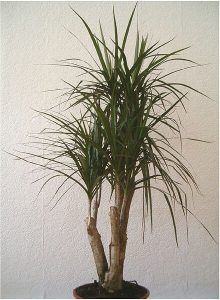 Another easy houseplant to grow at home is Dracaena marginata, or Dracaena marginata, belonging to the Lilaceae family.
Another easy houseplant to grow at home is Dracaena marginata, or Dracaena marginata, belonging to the Lilaceae family.
This African-born plant lives in tropical natural habitats, especially in Madagascar. Therein lies its very high capacity for adaptation, which makes it one of the best species to accompany you at home for a long time.
They are linear, with fine foliage and a length of approximately 30 to 90 cm. Its leaves show various very beautiful motley shades of red veins that intersect with an intense green.
Another characteristic that perfectly describes a Dracaena or Madagascar Dragon, as it is also known, is that as it grows, the lower leaves are lost to give way to a stem that arches on its own and exhibits striking shapes that are really perfect for decorating a corner of the house, because they are arranged in rosettes at the end.
bromeliads
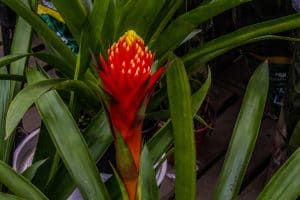 Bromeliads, from the Bromeliceae family, are exotic plants native to Brazil whose flowers are unique, because they turn into tall spikes of truly dazzling colors, almost phosphorescent, that are born in the center of the plant, very fleshy, tubular and with very bright foliage., of various shades.
Bromeliads, from the Bromeliceae family, are exotic plants native to Brazil whose flowers are unique, because they turn into tall spikes of truly dazzling colors, almost phosphorescent, that are born in the center of the plant, very fleshy, tubular and with very bright foliage., of various shades.
There are even some very curious mottled ones.
Actually, the flowering system of Bromeliads is very peculiar. They have very striking colors, from a bright red, through a pink, orange or fuchsia.
A special feature is that in the central area of the leaves, called bracts, it warns when the flower is approaching because it changes color. United, they offer a visual that is really as beautiful as it is striking because it is not a common flowering.
Another piece of good news is that flowering can last for several months, starting in spring, as long as the humidity and light conditions are suitable. This gift can also occur when grown indoors or indoors, as long as the minimum conditions it needs are reproduced.
caladium
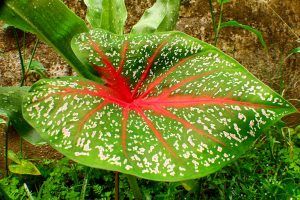 Another wonderful plant, the Caladium, belonging to the genus Caladium, is a true visual treat for its beautiful, large leaves painted deep red towards the center with gradient green edges.
Another wonderful plant, the Caladium, belonging to the genus Caladium, is a true visual treat for its beautiful, large leaves painted deep red towards the center with gradient green edges.
It is also known under the popular name of Heart of Jesus or Painter’s Palette. It is a gift of nature to take care of any of its 12 varieties, unique in the world, coming from Brazil, Guyana and other nations of South America.
One of the most showy is the Caladium bicolor. They all have perennial tubers and grow to a maximum of 90 cm.
The leaves are the best in the world!
They come from tubers and usually measure about 15 to 45cms in length and width. They come in colors such as crimson, red, white, and downright awesome bi-color versions.
Its leaves are 15 to 45 cm long and wide, and arise from tubers. These can be of very varied colors: white, crimson, red, and even bicolor.
Aralia
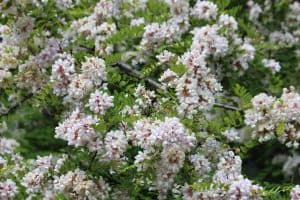 The Aralia, another plant of Asian origin that adapts very easily to indoor cultivation, has a peculiarity that makes it a favorite for decorating rooms and cheerful spaces: its leaves are a bright, very bright green.
The Aralia, another plant of Asian origin that adapts very easily to indoor cultivation, has a peculiarity that makes it a favorite for decorating rooms and cheerful spaces: its leaves are a bright, very bright green.
It is a resistant plant, which manages very well in lighted and shaded exposure sites.
Its scientific name is Fatsia japonica. This is the variety that best adapts to life in a pot and another, the Fatsia papyrifera, highly revered in the East because it allows the production of rice paper. This can have a height of up to 6 meters outdoors, under controlled conditions.
Some varieties have leaves spotted with small white spots.
Its foliage grows as if it were a short tree, with a thin, invisible trunk that reaches a certain level of visibility, which favors the existence of many ramifications of very shiny, palmate, lobed leaves.

![Photo of 25 Fast Growing Plants: [Types, Characteristics and Images]](https://www.complete-gardening.com/wp-content/uploads/2022/08/25-fast-growing-plants-types-characteristics-and-images-390x220.jpg)
![Photo of Complete Guide to Plant Blueberries: [12 Steps + Images]](https://www.complete-gardening.com/wp-content/uploads/2022/08/complete-guide-to-plant-blueberries-12-steps-images-390x220.jpg)
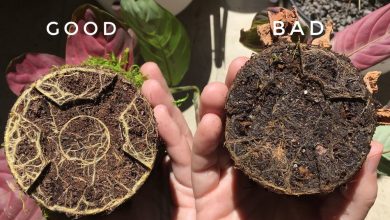
![Photo of Cold Climate: [Characteristics, Flora, Fauna and Adaptability]](https://www.complete-gardening.com/wp-content/uploads/2022/08/cold-climate-characteristics-flora-fauna-and-adaptability-390x220.png)